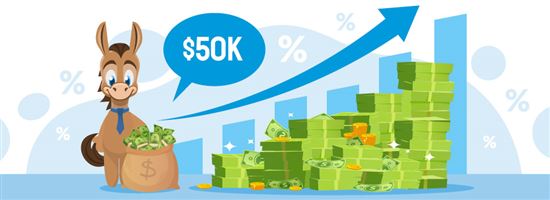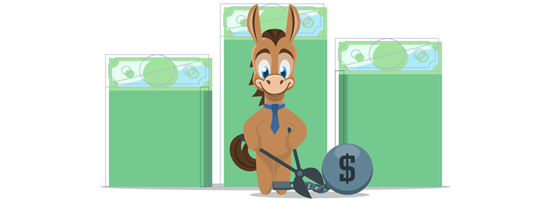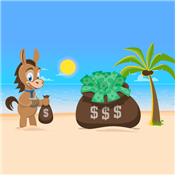Best Ways to Invest $50,000
Ad Disclosure: This article contains references to products from our partners. We may receive compensation if you apply or shop through links in our content. This compensation may impact how and where products appear on this site. You help support CreditDonkey by using our links.
Have $50,000 to invest? Here are 10+ smart investment ideas to turn $50k into even bigger money.
 |
Investing $50,000 wisely can help you build wealth, secure your future, and generate passive income. But where should you put your money? The best strategy depends on your financial goals, risk tolerance, and timeline.
This guide explores the best ways to invest $50,000, covering options like stocks, ETFs, real estate, bonds, and alternative assets. Plus, it'll highlight three investments to avoid so you can sidestep common pitfalls.
Here are the top 11 ways you can invest $50,000:
|
|
|
- UFB Portfolio Money Market:
Earn up to 3.76% APY - HealthcareBank:
Money Market Deposit Account - 4.36% APY - American State Bank:
Money Market Deposit Account - 4.03% APY - mph.bank:
Money Market Deposit Account - 3.96% APY - Blue Federal Credit Union:
Money Market Deposit Account - 3.75% APY - Great Lakes Credit Union:
Money Market Deposit Account - 2.50% APY - CIT Bank Money Market Account:
1.55% APY - Quontic:
Money Market Account - 4.25% APY
What to Do Before Investing
 |
| © CreditDonkey |
Before investing, make sure your financial foundation is solid. Jumping in without addressing key financial priorities can lead to unnecessary risk and lost opportunities. Here's what to focus on.
Pay Off High-Interest Debt
No investment consistently outperforms the cost of high-interest debt, so paying these off is a guaranteed return on your money. For example, if you're paying 24% interest on a credit card balance, even an investment earning 10% annually still leaves you with a net loss.
If your debt has a low fixed interest rate, like a mortgage or a student loan, you may still invest while making regular payments. The key is weighing potential investment returns against the interest you're paying—if your debt costs more than you expect to earn, paying it off makes more financial sense.
Maximize Retirement Contributions
If your employer offers a 401(k) match, contribute at least up to the match—this is free money that compounds over time. Even without a match, maximizing contributions reduces taxable income while building long-term wealth.
For 2025, you can contribute up to $23,500 to a 401(k) and up to $7,000 to an IRA. If you're 50 or older, you can make additional contributions of up to $7,500 to a 401(k) and $1,000 to an IRA. [1]
You could also consider a Roth IRA, which provides tax-free withdrawals in retirement. If you're self-employed, options like a Solo 401(k) or SEP IRA allow for higher contribution limits. Prioritizing tax-advantaged accounts before investing elsewhere ensures you aren't leaving money on the table.
Know Your Goals and Risk
Your investment strategy should align with your time horizon and risk tolerance
. If you need the money within five years, low-risk investments like high-yield savings accounts, CDs, and bonds provide stability. If you're investing long-term, stocks, ETFs, and real estate offer high growth potential.
Risk tolerance also plays a major role—investors comfortable with volatility may lean towards stocks and alternative assets, while those who prefer stability may favor dividend stocks or index funds.
No matter your approach, diversification is key. A mix of assets reduces risk and stabilizes returns, ensuring you aren't overexposed to market downturns.
Yes. Diversification can help you minimize risks and mitigate losses when the economy is experiencing volatility or uncertainty. Different types of investments will perform differently at different times depending on their specific market conditions.
How to Invest $50,000
 |
| © CreditDonkey |
Once you've managed debt, secured retirement contributions, and set clear financial goals, it's time to put your $50,000 to work. Your investment choices should align with your risk tolerance, time horizon, and income needs.
This section explores different ways to invest $50,000, from safe, low-risk options like high-yield savings accounts and bonds to higher-growth opportunities like stocks, ETFs, and real estate.
High-Yield Savings Accounts
Best For: Safe, short-term savings
Risk Level: Low
High-yield savings accounts (HYSAs) offer higher interest rates than traditional savings accounts while keeping your money fully liquid and FDIC-insured up to $250,000. HYSAs typically offer competitive interest rates, often exceeding 4%, making them a reliable option for emergency funds or short-term financial goals.
CIT Bank Platinum Savings - $300 Bonus
- Qualify for a $300 cash bonus with a minimum deposit of $50,000
- This limited-time offer to qualify for a $225 cash bonus with a minimum deposit of $25,000 or a $300 bonus with a minimum deposit of $50,000 is available to New and Existing Customers who meet the Platinum Savings promotion criteria. The Promotion begins on September 23, 2025, and can end at any time without notice.
Why Choose a HYSA?
These accounts carry no market risk, have no withdrawal penalties, and require no long-term commitment. Your funds are easily accessible, making them a safe place to park cash while earning modest interest.
What to Watch Out For:
HYSA interest rates fluctuate based on the Federal Reserve's decision, meaning your APY isn't guaranteed long-term. Returns are lower than stocks or real estate, and inflation may erode purchasing power over time. Some banks also require minimum balances to qualify for the highest rates.
Pros + Cons:
|
|
If you're investing for a near-term goal, safer investments like bonds, high-yield savings accounts, or CDs may be better. If you're in it for the long run, you could go with options like the stock or real estate markets. Ultimately, it depends on your financial goals, risk tolerance, and time horizon.
Certificate of Deposit (CDs)
Best For: Safe, fixed returns
Risk Level: Low
A certificate of deposit (CD) is a low-risk, time-based savings option that locks in your money for a fixed term, typically 3 months to 5 years, in exchange for a guaranteed interest rate. CDs often offer higher APYs than traditional savings accounts, especially for longer terms.
High-Yield CD Rates - Up to 4.00% APY
- No fees
- $1 minimum deposit
- FDIC insured
| Term | CD Rates |
|---|---|
| 3 Month | 4.00% APY |
| 4 Month | 3.50% APY |
| 6 Month | 3.50% APY |
| 9 Month | 3.40% APY |
| 12 Month | 3.30% APY |
Why Choose a CD?
CDs provide predictable returns with no market risk, making them ideal for conservative investors. Your interest rate is fixed for the entire term, so you know exactly how much you'll earn.
Additionally, CDs are FDIC-insured up to $250,000 per depositor, per insured bank, ensuring that your principal is protected.
What to Watch Out For:
CDs lack liquidity. Withdrawing funds before maturity usually results in early withdrawal penalties, often several months' worth of interest. If interest rates rise after you've locked in a CD, your money remains at the original lower rate, creating an opportunity cost.
Pros + Cons:
|
|
It depends on how you invest your money and what you like to invest in. For example, a high-yield savings account with 2% APY could earn you $1,000 after a year. 8% returns in the stock market would get you around $4,000.
Bonds
Best For: Stable and income diversification
Risk Level: Moderate
Bonds are fixed-income investments where you lend money to a corporation, municipality, or government in exchange for regular interest payments and the return of your principal at maturity.
Bonds are generally less volatile than stocks and provide a predictable income stream, making them useful for diversification and steady returns.
Here are the different types of bonds:
- Corporate Bonds: Issued by companies; higher yields but higher risk.
- Municipal Bonds (Munis): Issued by local governments; often tax-free at the federal level.
- Treasury Bonds (T-Bonds): Issued by the U.S. government; low risk but lower returns.
Why Choose Bonds?
Bonds offer steady, interest-based income with lower risk than stocks. They can help balance a portfolio and serve as a hedge against stock market volatility.
Treasury bonds are backed by the U.S. government, making them one of the safest investments, while corporate and municipal bonds typically offer higher yields in exchange for added risk.
What to Watch Out For:
Bond prices move inversely with interest rates—when rates rise, existing bonds lose value. Corporate and municipal bonds carry credit risk, meaning the issuer could default.
Treasury bonds are low risk but may not keep up with inflation, reducing purchasing power over time. Some bonds may also have lower liquidity, making them harder to sell quickly.
Pros + Cons:
|
|
Robo Advisors
Best For: Hands-off, low-cost investing
Risk Level: Moderate
Robo advisors are automated investment platforms that use algorithms to manage your portfolio based on your risk tolerance, goals, and time horizon. They typically invest in diversified ETFs and offer a low-cost, beginner-friendly way to grow your money.
Why Choose a Robo-Advisor?
Robo-advisors make investing simple and accessible by handling asset allocation, rebalancing, and tax optimization without requiring active management.
They're ideal for long-term investors who want a passive, low-fee approach to wealth-building. Many platforms have low or no account minimums, making them easy to start with.
What to Watch Out For:
Unlike human advisors, robo-advisors lack personalized guidance for complex financial situations.
And while fees are lower than traditional financial advisors, they still charge management fees (typically 0.25%-0.50% of assets). Market volatility can also impact your returns, just like traditional investing.
Pros + Cons:
|
|
Stocks
Best For: Long-term growth and wealth-building
Risk Level: Moderate to High
Investing in stocks means buying shares of a company, giving you partial ownership and the potential to earn through capital appreciation and dividends.
Over the long term, stocks have historically outperformed most other investments, making them a key part of wealth-building strategies.
Why Choose Stocks?
Stocks offer high return potential and historically outpace inflation, making them ideal for growing wealth over time. They also provide liquidity, allowing you to buy and sell shares easily.
Diversification across industries can help reduce risk while still capturing market growth.
You can buy stocks through an online brokerage account with platforms like Fidelity, Charles Schwab, and E*TRADE. Many brokers offer commission-free trading, research tools, and educational resources.
What to Watch Out For:
Stock prices fluctuate daily, which can be stressful for risk-averse investors. Unlike bonds, stocks offer no guaranteed income and companies can suspend dividends during downturns.
Successful investing requires research and discipline, as emotional decision-making often leads to losses.
Pros + Cons:
|
|
Mutual Funds or ETFs
Best For: Diversification and passive investing
Risk Level: Moderate
Exchange-traded funds (ETFs) and mutual funds allow investors to pool money into a diversified portfolio of stocks, bonds, or short-term investments. These funds reduce the risk of picking individual securities while providing broad market exposure.
- ETFs: Trade like stocks with lower fees and flexible buying and selling throughout the day. They're usually more tax-efficient since taxes only apply when shares are sold.
- Mutual funds: Buy and sell orders are processed only at the end of the day. Actively managed funds tend to have higher funds and may pass on capital gains taxes to investors.
- Index funds: A type of ETF or mutual fund that tracks like a stock market index like the S&P 500, offering low-cost, passive investing.
Why Invest in ETFs or Mutual Funds?
These funds provide instant diversification across multiple assets, making them a cost-effective way to invest in the market. ETFs typically have lower expense ratios and are more tax-efficient than mutual funds.
Many investors use these assets for long-term growth in retirement accounts like IRAs and 401(k)s.
What to Watch Out For:
Some mutual funds charge high fees due to active management, which can reduce net returns. Mutual funds also lack intraday trading flexibility since they only settle at the end of the day.
Additionally, like stocks, market volatility still affects fund performance, and returns aren't guaranteed.
Pros + Cons:
|
|
Real Estate Investing
Best For: Passive income & long-term appreciation
Risk Level: Moderate to High
Real estate offers multiple ways to invest, even without buying property outright. Investors can earn through rental income, property appreciation, or real estate crowdfunding platforms. Here are the main ways to invest:
- Direct ownership - Buy a rental property and generate passive income from tenants.
- REITs
- Invest in publicly traded funds that own income-generating properties.
- Real estate crowdfunding - Pool money with other investors into residential or commercial projects.
Why Choose Real Estate?
Real estate provides stable cash flow through rental income and can appreciate value over time. Crowdfunding platforms like Fundrise, CrowdStreet, and Groundfloor allow diversified exposure to the market without the hassle of property management.
Invest in Real Estate with $10+
- Only $10 minimum investment
- Get a diversified portfolio of real estate projects across the US
- Open to all investors
What to Watch Out For:
Real estate can be less liquid than stocks—selling a property or exiting an investment takes time. Market downturns can impact property values, and crowdfunding platforms may have high fees or investor restrictions.
If you choose direct ownership, that also comes with management responsibilities and unexpected expenses.
Pros + Cons:
|
|
Start Your Own Business
Best For: Entrepreneurs & high-risk investors
Risk Level: High
Starting a business can be a high-reward investment if planned well. With $50,000, you can launch an online store, a service-based business, or even invest in a franchise.
Although success isn't guaranteed, a solid business plan and strategic execution can turn an initial investment into a profitable venture. You could explore businesses like:
- E-commerce or dropshipping
: Start an online store with minimal overhead costs.
- Service-based businesses: Consulting, freelancing, or digital marketing require low startup expenses.
- Franchise ownership: Invest in a proven business model with brand recognition and support.
Why Start a Business?
Owning a business provides financial independence and the potential for high profits. Unlike traditional investments, business success depends on execution, strategy, and market demand.
Some industries, like online businesses, require low initial capital while offering scalability.
What to Watch Out For:
Many startups fail within the first few years due to poor planning, cash flow issues, or lack of demand. You also need to be prepared for long hours, unexpected expenses, and financial risk.
Market research and a detailed financial plan can improve your success rate.
Pros + Cons:
|
|
Financial Advisors
Best For: Personalized financial planning
Risk Level: Low to Moderate
A financial advisor provides expert guidance on investing, retirement, taxes, and long-term wealth planning. They tailor strategies based on risk tolerance, financial goals, and market conditions, helping clients make informed decisions.
Common types of financial advisors include:
- Fee-only advisors: Charge a flat fee or percentage of assets; no commissions, minimizing conflicts of interest.
- Commission-based advisors: Earn commissions from financial products they sell; may have potential bias in recommendations.
- Robo-advisors with human oversight: Hybrid services that combine automated investing with personalized financial guidance.
Why Work with a Financial Advisor?
Advisors help create a comprehensive financial plan that includes investment strategy, tax planning, estate management, and risk mitigation. They offer regular check-ins to adjust strategies based on financial changes, ensuring long-term financial security.
What to Watch Out For:
Financial advisors charge fees (typically 0.5% to 2% of assets under management for full-service advisors[2]). Commission-based advisors may recommend higher-fee products that benefit them.
Not all advisors operate as fiduciaries, meaning they aren't always legally required to act in the client's best interest.
Pros + Cons:
|
|
Cryptocurrencies
Best For: High-risk, high-reward investors
Risk Level: High
Cryptocurrency is a digital asset that operates on blockchain technology and can be used for transactions or held as an investment.
To buy crypto, investors need to open an account with a cryptocurrency exchange like Coinbase, Binance, or Kraken. These platforms allow users to trade digital assets, store them in a crypto wallet, and access various investment tools.
Why Invest in Crypto?
Cryptocurrency offers a significant return potential due to price fluctuations. The market operates 24/7, allowing for flexible trading opportunities. Some cryptocurrencies also provide staking rewards and yield farming, enabling passive income generation.
What to Watch Out For:
Crypto markets experience extreme volatility, with price swings exceeding double digits in a single day. Unlike traditional assets, they lack government regulation, making them vulnerable to fraud, security risks, and sudden policy changes.
You should also consider high transaction fees, liquidity concerns, and tax implications. Also, if you invest in crypto, make sure you have a secure crypto wallet to store your funds.
Pros + Cons:
|
|
Alternative Assets
Best For: Portfolio diversification and high-risk investors
Risk Level: High
Alternative investments include assets outside of stocks, bonds, and cash. These investments often have lower liquidity and higher risk, but they can provide unique opportunities for portfolio diversification.
Common types of alternative investments include:
- Whiskey and wine investments: Rare whiskey and fine wine can appreciate in value over time. Some investors purchase bottles to resell, while others use platforms like Vinovest that offer fractional ownership of investment-grade spirits.
- Collectibles and fine art: Rare assets like art, sneakers, trading cards, and luxury watches.
- Commodities: Physical goods like gold, silver, oil, and agricultural projects, which add diversity to a portfolio.
Why Consider Alternative Investments?
Alternative assets can provide exposure to different asset classes that may perform differently to traditional investments.
Some, like fine art or rare whiskey, have historically increased in value over time. Collectibles and commodities are often driven by supply and demand, making them attractive to niche investors.
What to Watch Out For:
Many alternative investments are illiquid, meaning they can't be easily sold for cash. They also lack regulation compared to stocks and bonds, increasing risks of fraud or mismanagement.
Also, some require high minimum investments and are subject to shifting market demand. Performance can be highly variable, and alternative assets may not always provide the expected diversification benefits.
Pros + Cons:
|
|
3 Investments to Avoid
Not all opportunities labeled as "investments" are worth considering. Some come with high risks, low returns, or even outright fraud. Some risks, low returns, or even outright fraud. Here are three types of investments to be cautious of:
- Penny Stocks
Penny stocks trade for under $5 per share and often belong to small, unproven companies. While they may seem like an affordable way to enter the market, they're highly volatile, illiquid, and lack financial transparency.The truth is that many of these companies never become profitable—making penny stocks a speculative and risky investment.
- Pyramid scheme
Pyramid schemes disguise themselves as business opportunities but rely on recruiting others to bring in money rather than selling legitimate products or services. These models are unsustainable—most participants lose money, while only those at the top benefit.If an investment requires upfront payments and recruiting others to profit, it's likely a scam.
- Gambling and lottery tickets
Gambling isn't an investment strategy. Casinos, sports betting, and lotteries operate on systems where the odds favor the house, not the player.While a big win is possible, statistically, most people lose money over time. Instead of gambling, investing in assets with long-term growth potential is a more reliable way to build wealth.
How to Choose the Best Investment
The right investment depends on your goals, risk tolerance, and time horizon. Here's what to consider before investing your $50,000.
- Define your investment goals
Short-term goals (1-3 years) require safe, liquid options like high-yield accounts or CDs. Mid-term goals (3-10 years) may benefit from ETFs, bonds, or real estate. Long-term goals (10+ years) are best suited for stocks, real estate, or retirement accounts. - Assess your risk tolerance
Higher returns come with greater risk. Stocks and crypto offer growth but experience volatility. Bonds, CDs, and high-yield savings provide stability but lower returns. Real estate and alternative assets diversify portfolios but may have liquidity risks. - Consider liquidity needs
If you need quick access to cash, savings accounts, stocks, and ETFs are best. Bonds, REITs, and index funds offer moderate liquidity, while real estate requires a long-term commitment. - Factor in fees and taxes
Investment costs reduce returns. ETFs and mutual funds charge expense ratios, while capital gains taxes apply when selling assets. Financial advisors and robo-advisors may also charge fees. Minimizing these costs helps grow your wealth. - Diversify your portfolio
A mix of stocks for growth, bonds for stability, real estate for passive income, and alternative investments for diversification reduces risk and improves long-term returns.
What Experts Say
As part of our series on saving and investing, CreditDonkey assembled a panel of industry experts to answer readers' most pressing questions.
Here's what they said:
Bottom Line
Investing $50,000 can grow your wealth, but the right strategy depends on your goals, risk tolerance, and time horizon.
Low-risk options like high-yield savings and CDs offer stability, while ETFs, real estate, and stocks provide growth potential. Higher-risk assets like crypto can deliver high returns but come with volatility.
Before investing, manage debt, secure retirement savings, and set clear goals. Avoid speculative bets like penny stocks and pyramid schemes, which often lead to losses. Instead, focus on diversified, long-term investments that align with your financial plan.
The earlier you invest, the more time your money has to grow. A well-researched, diversified approach can help you make the most of your $50,000.
Deposit $50,000, get $1,000 in NVDA stock + 8.1% APY on uninvested cash
Terms and conditions apply
Transfer and Earn Up to $5,000 Bonus
Enroll your new eligible TradeStation account in this offer either by using promo code BDEVAGFG on your new account application or by requesting to enroll, via telephone, with a TradeStation Representative. Within 45 days of account enrollment, fund your account with at least $500. Maintain at least $500 in your account for 270 calendar days. New assets will be aggregated during the 45-calendar day period following the enrollment date to determine the amount of your cash offer.
| New Assets | Cash Bonus |
|---|---|
| $500 - $24,999 | $50 |
| $25,000 – $99,999 | $250 |
| $100,000 – $199,999 | $400 |
| $200,000 – $999,999 | $800 |
| $1,000,000 – 1,999,999 | $3,000 |
| $2,000,000+ | $5,000 |
CIT Bank Platinum Savings - $300 Bonus
- Qualify for a $300 cash bonus with a minimum deposit of $50,000
- This limited-time offer to qualify for a $225 cash bonus with a minimum deposit of $25,000 or a $300 bonus with a minimum deposit of $50,000 is available to New and Existing Customers who meet the Platinum Savings promotion criteria. The Promotion begins on September 23, 2025, and can end at any time without notice.
Business Premium Savings - Up to 3.80% APY
- Bundle with checking and unlock a bonus of up to $600.
- Discover the Axos Business Bundle, combining flexible checking with high-yield savings and earn an exclusive bonus up to $600. Use promo code SBB600.†
- Earn 3.80% APY* With Business Premium Savings
- Free domestic and international incoming wires
- No monthly maintenance fee
- No minimum opening deposit
- No average daily balance requirement
- Business deposit accounts FDIC insured up to $250k
High-Yield Savings Account - $1,000 Bonus
New customers only. Earn $1,000 for a minimum of $100,000 deposited on the Raisin platform within 14 days of your first deposit date and maintained over 90 days. To qualify for the bonus, the first deposit must be initiated by November 30, 2025, by 11:59 PM ET, and the customer must input code EASY at the time of sign-up.
References
- ^ IRS. 401(k) limit increases to $23,500 for 2025, IRA limit remains $7,000, Retrieved 03/10/2025
- ^ Investopedia. The Real Cost of a Financial Advisor, Retrieved 03/13/2025
Write to Rebecca M at feedback@creditdonkey.com. Follow us on Twitter and Facebook for our latest posts.
Note: This website is made possible through financial relationships with some of the products and services mentioned on this site. We may receive compensation if you shop through links in our content. You do not have to use our links, but you help support CreditDonkey if you do.
Fundrise, LLC ("Fundrise") compensates CreditDonkey Inc for new leads. CreditDonkey Inc is not an investment client of Fundrise.
|
|
|














